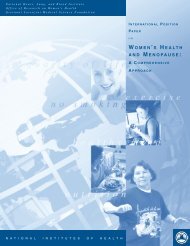HeartsNParks Community Mobilization Guide - National Heart, Lung ...
HeartsNParks Community Mobilization Guide - National Heart, Lung ...
HeartsNParks Community Mobilization Guide - National Heart, Lung ...
You also want an ePaper? Increase the reach of your titles
YUMPU automatically turns print PDFs into web optimized ePapers that Google loves.
86<br />
Your department can take various steps to increase the accuracy of outcome measurements:<br />
Program Group and Comparison Group. Outcomes measurement in community<br />
recreation programs usually involves one group—for example, all adults who attend a swimming<br />
program.<br />
To improve the accuracy of your assessment results, create a comparison group and involve one of those<br />
program groups in the heart-healthy information and activities. The other program group called the comparison<br />
group is not exposed to the healthy information and activities.<br />
Example: Your department sponsors after-school programs at several local elementary schools. Some of<br />
the programs receive the special heart-healthy activities and some of them do not, but both groups take<br />
pretests and posttests.<br />
Self-Selected Groups. Most participants in recreation programs are self-selected, meaning that they<br />
themselves made the decision to become involved or, in the case of children, have parents who made that<br />
decision for them. This means that your measurements cannot necessarily be generalized to a larger population,<br />
such as all senior citizens or all Hispanic women.<br />
Example: Teens who regularly show up at your department’s midnight basketball program may be different<br />
from other teens in the neighborhood who choose not to be a part of this program.<br />
Random Selection. You can also improve the generalizability of your assessment by randomly selecting<br />
the participants whose outcomes will be measured. In this way, participation in the program is determined<br />
by chance, ensuring that those tested are more representative of the larger population.<br />
Example: Slips of paper with the names of 50 adults in a senior lunch program are placed in a bowl; the<br />
first 20 names randomly selected are invited to participate in a fitness program. If you can’t select participants<br />
randomly, you may be able to systematically select program sites. That will allow you to avoid selecting<br />
sites whose outcomes might bias the results because these sites are more conveniently located for<br />
participants or because more program staff members have a greater interest in operating the program.<br />
Multiple Measures. Another way to boost the rigor of your assessment is to use all of the measures in<br />
the sample surveys.<br />
ANALYZING AND REPORTING RESULTS<br />
Instructions for administering and scoring your<br />
participants’ performance assessments are<br />
provided on pages 91 and 92. Answer keys and<br />
scoring sheets are found in appendix B.<br />
■ Be sure that you’ve selected the right<br />
instruments—children, for example, should<br />
take tests designed for children in their age<br />
bracket.<br />
■ Be sure that you’ve selected the right<br />
scoring sheets.<br />
After you’ve scored each individual test, add<br />
up the scores of all participants and divide by<br />
the number of participants. This will give you<br />
the average score for the group. It may help<br />
you to write all the scores on one page, total<br />
them, then divide by the number of scores.
















